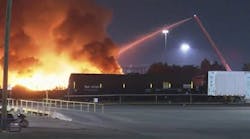As a fire company officer, you should attempt to maximize any activity that you and your company perform together. One sure-fire way to intensify your energetic output is by conducting a company "walk-through."
Having prior knowledge of a building (before it is on fire) is priceless when it comes to staying safe. The time you spend "walking through" will pay huge dividends if the occasion arises when there is a fire. Valuable information is best gathered firsthand by you and your company before the alarm. It is far less effective (and not retained) when it is seen only on paper in a pre-plan drawn up by someone else.
Take the time to drive slowly and look around when out in the apparatus. The accompanying photos provide an example of what you can learn by just observing your surroundings.
While returning from an alarm, my company and I noticed this ordinary-constructed building. What was obvious to all was the process of "closing up" the windows using cinderblocks (see photo 1). I quickly envisioned a fire in the building, and how the process of horizontal ventilation (and all of its direct benefits) would be greatly hampered by this construction feature. I also pictured how much more difficult (read: IMPOSSIBLE) it would be for firefighters inside to rapidly exit the building should the need arise.
We parked the apparatus for a quick walk-through. With the permission of the tenant, we entered to get an idea of the layout in the event we ever have a fire there.
The building was empty due to the renovations taking place. We found the second floor being supported by screw jacks on the first floor to correct a major sag of the second floor (see photo 2). While engineers argue over the strength of steel, I will stick with the teaching that the temporary metal jack would distort in a fire situation prior to that heavy timber column.
We went up to the second floor and observed conditions which only exaggerated the situation. The building was undergoing renovation. It had a weakened second floor, as evidenced by photo 2. Most critical was the intense concentrated loading where the cinderblocks were stacked (see photo 3) directly above the screw jacks on the first floor. No wonder the floor was sagging.
All these elements screamed of disaster. Luckily, there was an in-service sprinkler system, as can be seen in photo 3.
We are taught that buildings under renovation are very susceptible to collapse due to the nature of construction. Some critics will say the building is empty and therefore no threat to firefighters. Others will say the building is sprinklered, and won't have a fire. It took us only 10 minutes to conduct our walk-through but in doing so the members discovered a temporary condition with some serious potential. They got an idea of the floor layout as well as construction features.
This officer contacted the fire prevention inspector, who confirmed that all activities by the owner were legitimate (though questionable in the eyes of line firefighting troops).
Always keep your eyes open. There are many settings like this in every community on any given day. You just need to be observant while out with your company to spot them. For your safety and the safety of your members, don't become complacent.
The few minutes it takes to stop and "check out" a situation will be worth the effort. Always contact code enforcement officers if you discover something that just doesn't seem right. They are a great source of information.
Mark McLees is captain of the Syracuse, NY, Fire Department Rescue Company.







